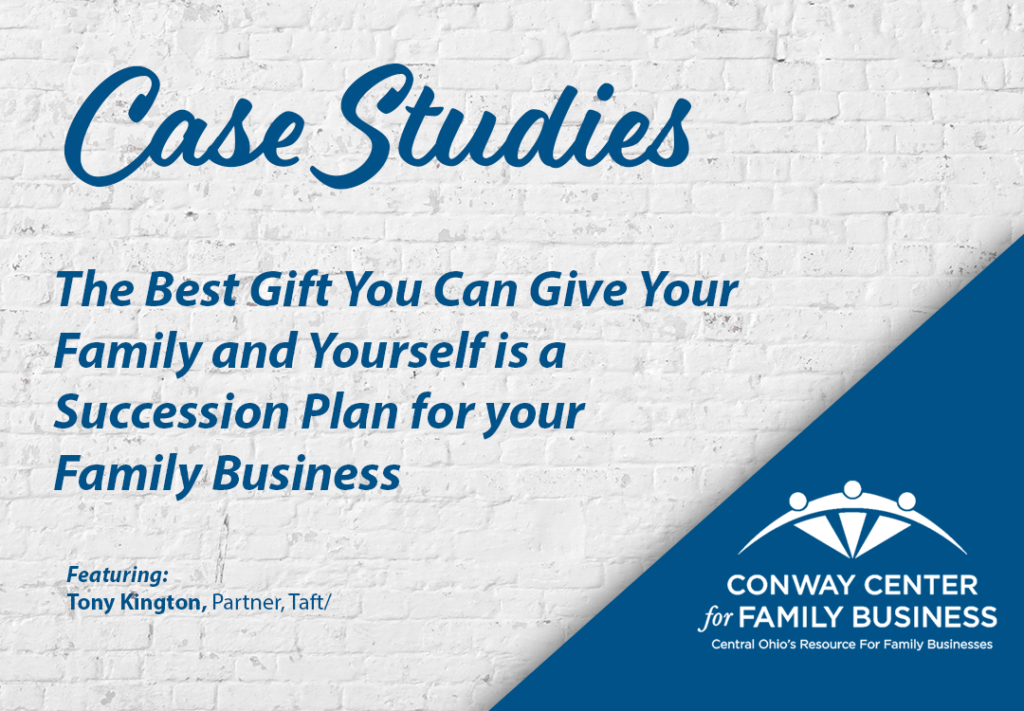What’s the secret to an effective succession plan for your family business?
There really isn’t a straightforward answer.
The Conway Center for Family Business has helped many businesses through succession planning challenges, and one thing is for certain – no two businesses are alike. Differences in family dynamics, interpersonal relationships, preparedness, non-family employee input, and countless other challenges on top of managing a business’ day-to-day operations make each succession plan a unique case-by-case puzzle.
Still, there are some common lessons each family business can take to help fill those missing pieces.
Identifying a Family Business Successor
Starting a conversation about succession can be difficult for all involved. The generations that launched a family business may not have thought about stepping away from their role. In some cases, they may find it uncomfortable to talk about what happens if they lose capacity to do their job effectively, and need a bit of nudging from the younger generations. The next generation may also feel unprepared to step into that leadership role.
Simply thinking about your successor can help start the process. Evaluating your options, whether it be passing the baton to the next generation, establishing an employee stock ownership plan, or selling to a third party, can prompt some tough questions.
Tony Kington shares a few questions that may be tough to address now, but if explored early can ease a potential transition:
Do you currently have management in place to run your business?
Can someone sit in the “big chair” when you’re not there? For example, your spouse may know your accountant and your attorney, but does he or she know who your key vendors are, what legal issues your business deals with or where to find the business’ vital financial information?
If not, you need to determine if someone in your business is ready to become its leader and begin training that person in the details unique to your business.
Will your family receive sufficient income to survive from the sale of your business?
- If you sold your shares of the company how would it affect your bottom line?
- How will your exit affect your company’s finances? It’s important to take a realistic look at the numbers now in order to prepare for the future.
Is your family active in your business AND willing/able to remain active in your business?
Is there someone who will sit on your board of directors that is qualified to oversee business issues? The answer to this question will help you determine if it’s practical to keep the company in your family.
Do you have a qualified buyer?
Although you may not be thinking of selling to an outside buyer, you may want to consider this option and its financial repercussions to make informed succession decisions.
Based on your answers to these questions, ask yourself:
- Where do we want the business to go?
- What is our goal for the business?
- Do we want to continue our business?
- Does someone else want to continue the business?
- Do we need to consider selling our business?
The process starts with asking yourself these questions and honestly evaluating the answers to create a plan that works for your business.
Tough Questions, Tougher Family Business Issues
Two of the most difficult topics for any person to discuss are front-and-center during succession planning – your death and your money!
Once you become comfortable with addressing these issues, the rest can be easier and you can prevent a lot of headaches down the road. It is much better to begin the process now than for your family to learn on the job after your death.
Kington says anything you can do to prevent surprises for your successor will help smooth their transition into a new role.
“Think deeply about the skills and experience needed for each role, including your own management and communications style, and then determine who can best fill those roles. If someone needs help developing an essential skill, take the time to help that person grow into a role that best fits them. Finally, be sure to openly communicate your choice to key decision makers in your business so that they can work together to plan for the future,” says Kington.
Kington adds that another difficult issue to address is the division of the business among family members.
“The first thought is typically to divide everything equally. However, equal may not translate into fair when you are dividing up a family business. Be sure to look at all forms of compensation, including income and equity, and consider how you should divide them among family members in a way that will allow the business to continue successfully,” says Kington.
Taking Action on a Family Business Succession Plan
Few roadmaps will accurately capture your business’ succession planning and transition path, but you can – and should – establish key stages and action steps that make sense for your business.
Consider laying out “phases,” like these examples below, to keep yourself and others on track during the planning process:
- Phase 1: Choose a new leader(s).
- Phase 2: Mentor your new leader(s).
- Phase 3: Create a timetable so that everyone knows what to expect and when to expect it.
- Be sure to communicate this information to everyone involved.
- Phase 4: Develop an exit plan.
- Old leaders can still lead if they are able, but during transition should be careful not to undermine new leadership by overruling critical decisions. It’s okay to consult with new leaders to offer guidance, but they need to be the leader both on paper and when it comes to making important business decisions.
Selling the Family Business
If you decide selling the family business is in the best interest of the company and your family, you’ll be presented with another set of questions and considerations. Securing a buy/sell agreement could be urgent, or you may want to establish steps in case of a trigger event, like death, bankruptcy or divorce.
In any selling scenario, first think about what you want to achieve. When do you want the buy/sell to occur, and what is an appropriate price? You may have a formula in mind, but you should also consult external resources to find out the appraised value of your business, and factor that into your calculations. Some business owners are shocked to learn the value they place on their business is far different than how it is appraised.
Finally, consider other terms and funding issues. Ask yourself where and how you will receive that money, and how it affects the rest of your family. In what new ways will you receive consistent income? Some options to consider include life insurance, seller financing and bank financing or a combination.
Key considerations to help transition your family business to the next generation
The bottom line is that succession planning should begin far before it becomes a necessity. By opening the lines of communication and discussing the future of your business with family members and key employees, you can help ensure the continuity of your business for years to come.
Kington recommends keeping these considerations in mind:
1. Start early. The planning process should begin five to ten years before you plan to retire. This gives you time to groom and train your successor.
2. Involve your family. Start an open dialogue with family members that allows everyone to voice their desires and discuss all options. The person you think may want to be your next leader may not be interested in taking on that role.
3. Evaluate your family realistically. Take some time to think about family members. Can they get the job done? Will they get along? Do they even want to be the owner?
4. Set up shares and interests. Don’t just think in terms of equal distribution. Equal shares may not be fair based on other aspects of the business and your estate. Look at ownership and management issues to determine a fair distribution of shares.
5. Train your successor. Use the time that you are still active in the business to pass on your knowledge and experience.
6. Develop a transition plan. It’s important to put key phases in writing so you and your stakeholders understand the business’ course of action.
7. Involve outsiders. Using an advisory board, business coach, or other external professionals can get you honest answers from a fresh perspective. The Conway Center for Family Business offers several educational programs and peer groups that are free to members and can help you share concerns while receiving feedback from other businesses who have been in your position.
Learn more about topics like succession planning and planning for retirement by reading a Conway Center for Family Business eBook.
About the Conway Center
The Conway Center for Family Business is Central Ohio’s resource for educational programs, resources and networking opportunities to support the growth and success of family-owned businesses. The Center celebrates the successes of family-owned businesses at its annual awards program and offers peer group opportunities for next-generation leaders, family business leaders, and women family business owners. The organization includes more than 200 family-owned businesses from Central Ohio that employ more than 35,000 individuals.
Learn more about Conway Center for Family Business membership.

